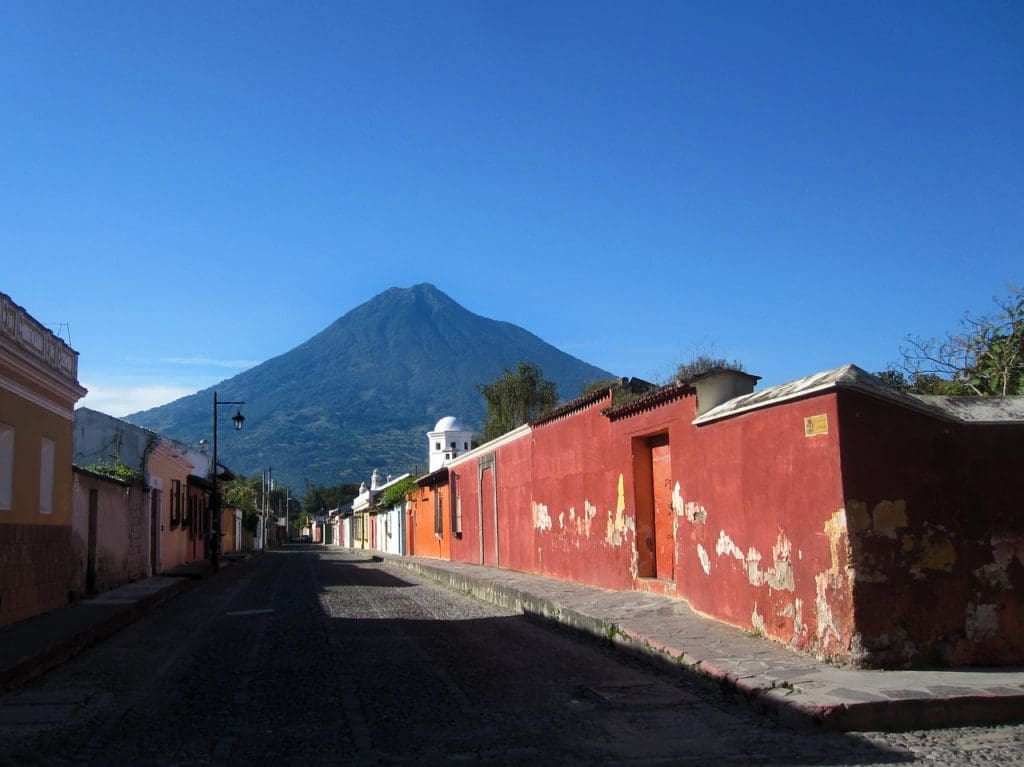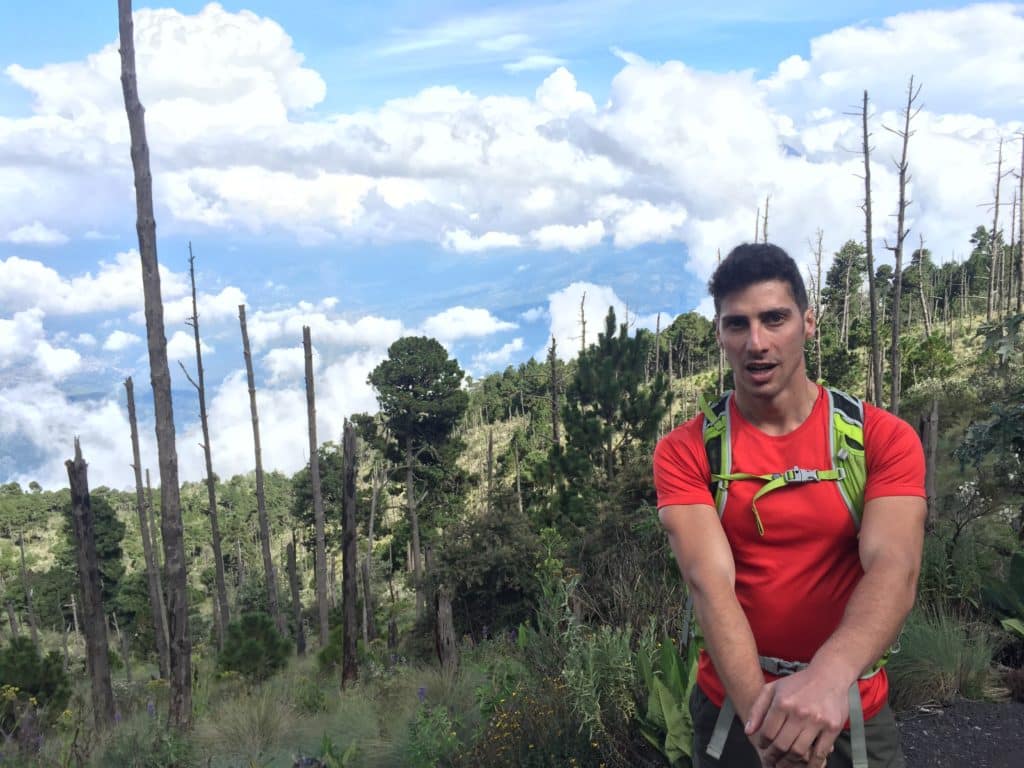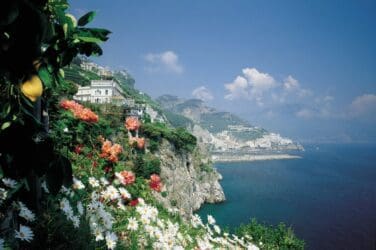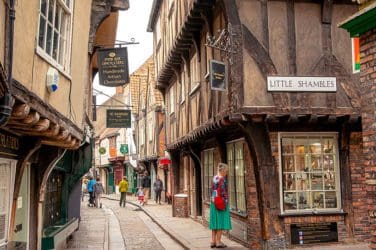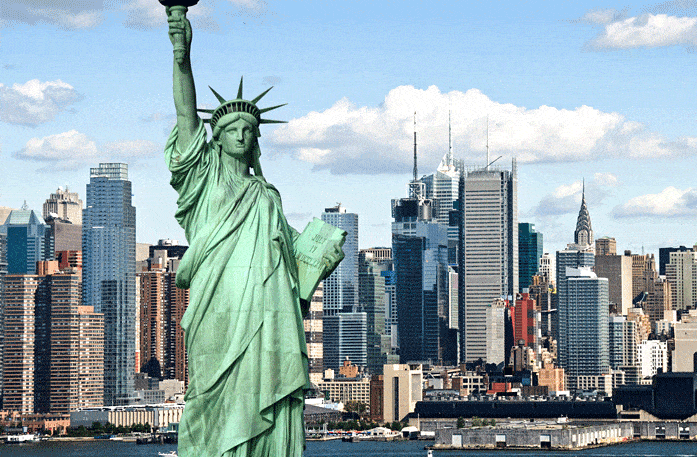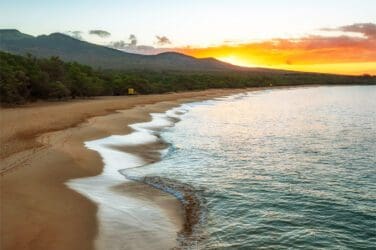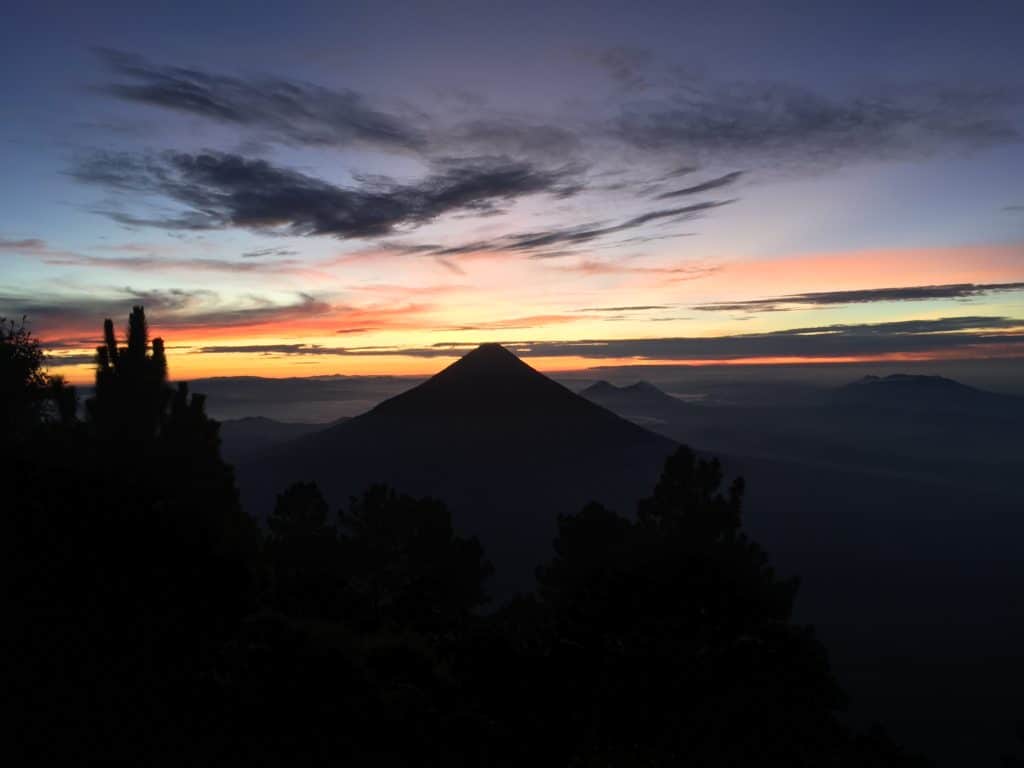
They call the town La Soledad – ‘the loneliness’.
You don’t need to ask why. Arriving early one Wednesday morning, we find a misty mountain village punctuated by pack mules, wandering dogs, and silent, staring children. Old men with rivulet wrinkles watch us go by. Iron rooftops disappear in the grey clouds.
We’re 2400m above sea level, but we could be in purgatory. Either way, we’re about to suffer. Ahead of us is Acatenango, second-highest peak in Guatemala and one of the tallest volcanoes in central America. It’s just shy of four thousand metres, and it’s active. Today we’re climbing to the summit, tonight we’re camping on it, and tomorrow we’re returning.
If we make it.
By Chris Zacharia
Fortunately, we’re not alone. David has climbed Acatenango 300 times. He’s done it in rain, thunderstorms, and, yes, eruptions. He’s confident, but maybe not quite as breezy as you’d expect from someone who’s reached the summit of this peak more times than I’ve reached my attic.
‘You have to respect the volcano’ he says.
Is it hard?
‘Is…intermediate’ Then, seeing the look on my face, ‘But no, is not hard’
First comes farmland. Corn, turnips, and coffee, all growing in unmoving platoons. Farmsteads of corrugated iron stand watch, La Soledad disappearing behind them. The track that we’re walking resembles coffee grounds, crumbly pellets the colour of Arabica roast but much harder to grip. The mist makes it hard to see more than a few feet ahead.
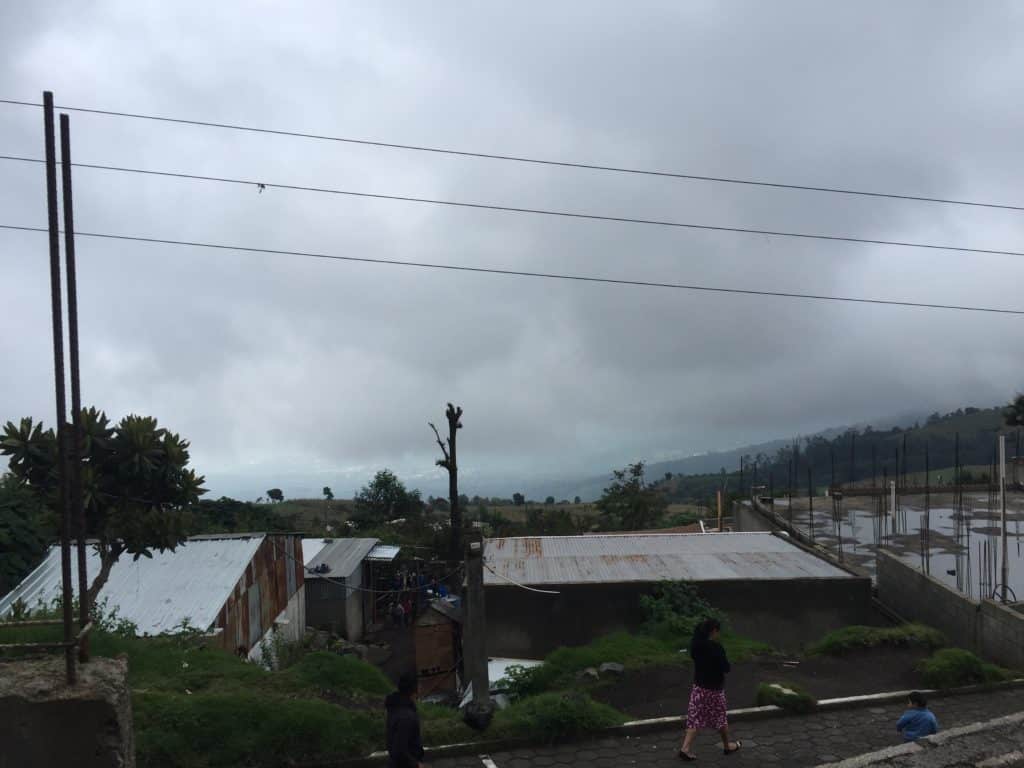
‘Buenos’ say the descending hikers, streaming down in twos and threes. I search their faces for clues, but none of them seem distraught or bereaved of an unfortunate hiking buddy. They’re all alive, at least.
But the farmland is tough going. Already the air is noticeably thinner. Like inflation, we’re getting less bang for each buck of breath. Every fifty metres or so, we find ourselves having to pause, leaning on our walking sticks, surprised by this sudden curtailing of our stamina.
‘Ready?’ asks David, eyes eager.
No, we’re not ready. But we keep going.
Acatenango is home to four distinct ecosystems. After an hour the first ecosystem, farmland, gives way to the second: cloud forest. Imagine the hilly jungles of Central America, the kind you see in guidebooks – vines, misty treetops, mysterious birdcalls. That’s the cloudforest, and you’ve got around two hours of climbing to enjoy it. Eventually it yields to pine forest, and finally a volcanic wasteland covering the summit like a crown.
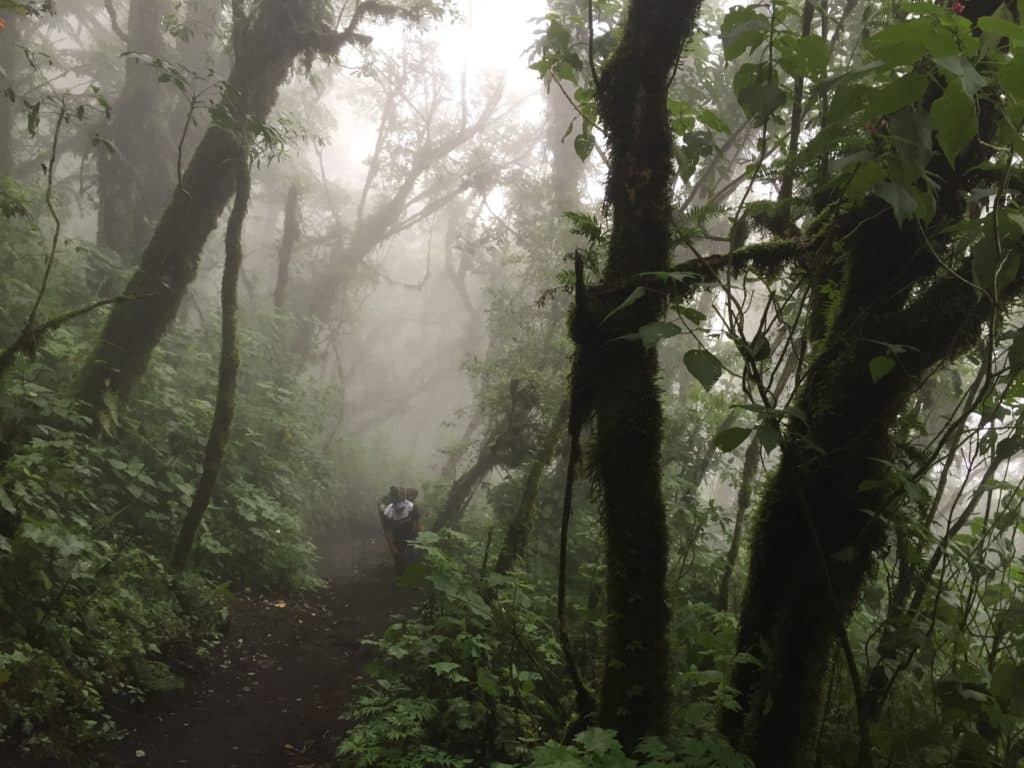
A winding trail pulls us up into the clouds. Each step feels like a great lunge, making my thighs scream. We pause, but there’s not much to see: the cloud enshrouds every little gap in the trees, making you feel curiously suspended in space. I try to strike up conversation, but the gaps…in my breath…make it hard…to talk. Silence serves us better. Occasionally bird-calls pierce the quiet. Over 100 species of bird live upon the volcano, many of them indigenous.
Puddles of sunlight appear. A few minutes later we burst through the cloud and emerge in the dazzling sunshine above. The light purifies the branches and leaves, making them much sharper and more distinct. And the views are suddenly vast and breathtaking, if we had any breath left for them to take.
Cloud forest thins out, the mist lifts, and we find ourselves among the pines. We see the town of Antigua down below, a patchwork of white and brown, a whole world made miniature and insignificant. Hard to believe we set off from there early this morning.
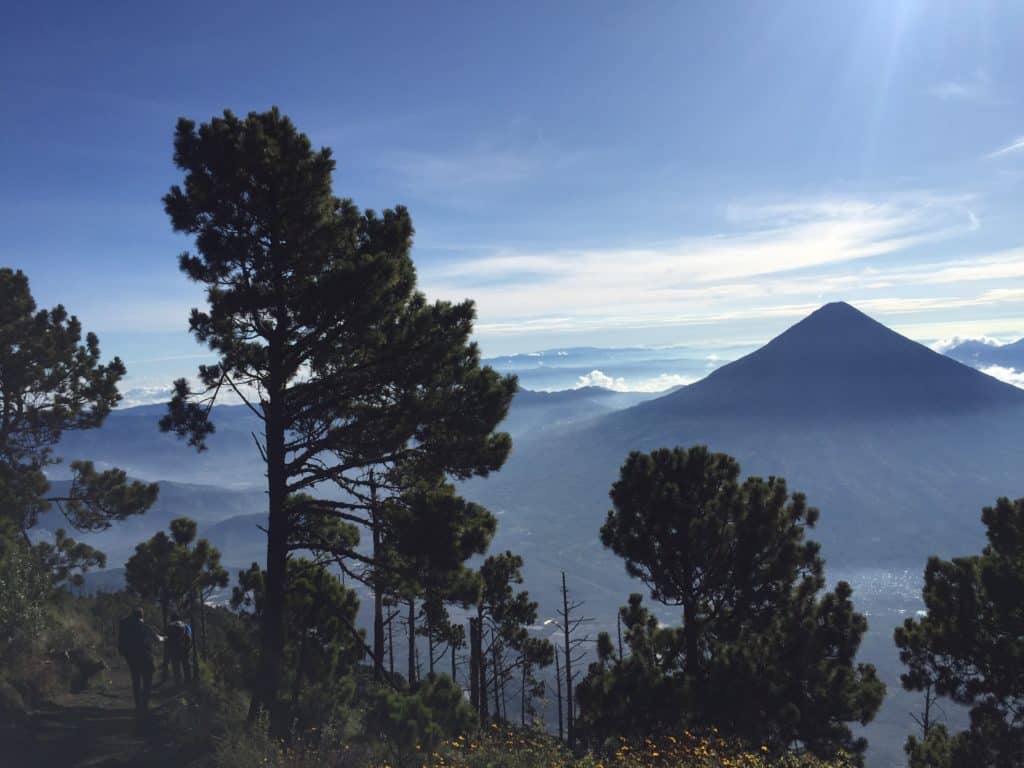
We have lunch on a promontory above a sea of cloud. David has prepared a do-it-yourself sandwich buffet. There’s bread from an Antiguan bakery, tomatoes, peppers, ham, and more. Incredibly, David then begins to make fresh guacamole.
‘Oh, I almost forgot this’ he says with a grin, peeling open a tin can to reveal jalapeños. ‘You can’t have a sandwich without it, man!’
Famished from four hours of climbing, we relish our sandwiches, enjoying mouthful after mouthful while gazing meditatively at the pattern of land and cloud.
Slaloming around the mountain, the terrain becomes flatter. Beautiful views hang like paintings mounted upon the sky. We’re an hour from camp. It faces Fuego, Acatenango’s sister volcano, and far more explosive. Already we can feel the rumble beneath our boots.
Our campsite is pitched with much relief. We’re now 3600m up, only 400m or so from the summit. My legs feel oddly springy on flat ground. But we’re not short of excitement. Fuego, Acatenango’s seething sister volcano, dominates the horizon. From here on Acatenango, you’re close enough to see the ridges and crests that form Fuego’s rugged shoulders. A third volcano, calm placid Agua, occupies the far left of our vista, its symmetrical slopes smoother, reminiscent of Mount Fuji.
Then, Fuego erupts. A sudden crack, and a vast plume spreads into the sky. Everyone gasps and claps, even David, who’s seen this thousands of times.
Over the next hour, we watch Fuego’s eruptions like fireworks. We learn to differentiate the sounds: the percussion of falling stones, the pressurised air escaping from the fissures, the moan of moving magma. It sounds like a jet engine, like thunder, like breaking glass.
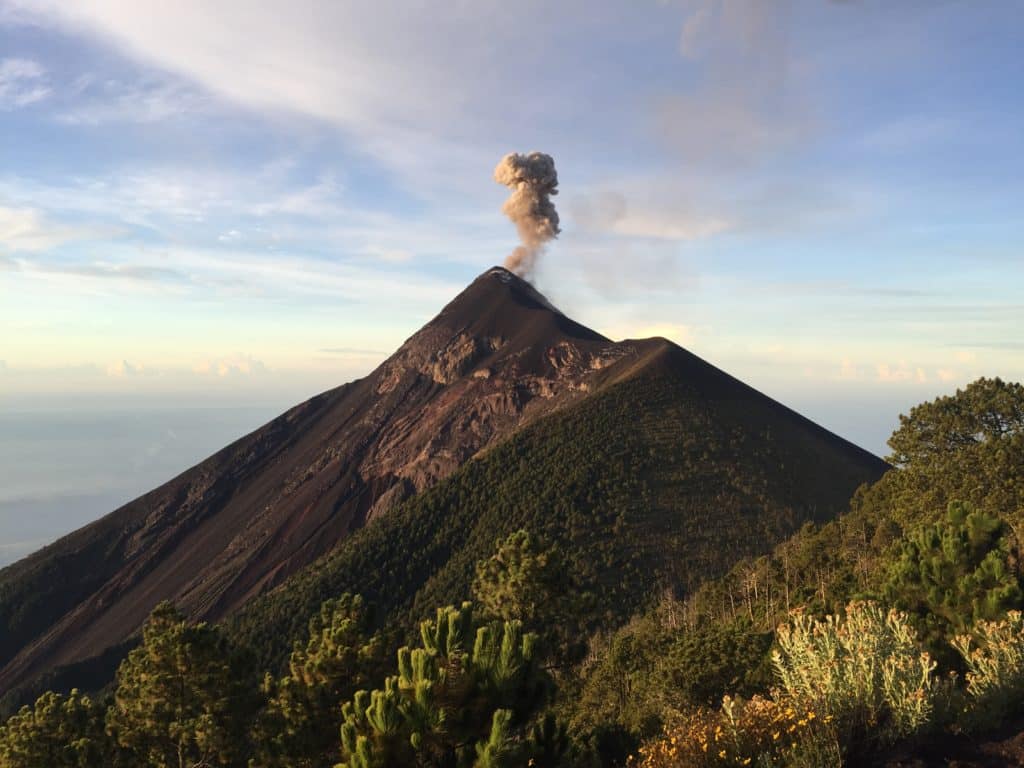
As sunset approaches, David gives us the sign. We’re going to summit Acatenango. Although we’re less than 500m off, David estimates that it will take at least an hour and a half.
‘Or more, if there is a thunderstorm’ he says.
But probably no thunderstorm?
‘No, probably not. But the weather can change fast’ he grins.
It’s not bad at first. The alpine forest recedes and is replaced by tenacious shrubbery, stubbornly clinging to the slopes. Then the ground becomes crumbly, so crumbly that each footstep triggers a cascade of ashen dirt.
‘Tread in my footsteps!’ David says. ‘Less likely to slip’
The sky seems to be getting closer, and the land more remote. Yet my head won’t turn to look. It’s so steep, my stomach churns just thinking about it. David tries to point out some sights in the distance but my gaze remains fixed on the ground. One step at a time.
I’m still staring at my boots when David cries out.
‘This is the last one hundred metres!’ he says, gesturing to what looks far too steep to be our trail. ‘It’s hard, but if you go quickly, you’ll find it easier’
I follow David’s advice, but only because I’m too scared to pause. The track is so steep I use my hands to navigate the volcano’s stony face. It’s also very narrow. Either side of me is a precipitous drop to jaw-like rocks. Out of nowhere, I burst out laughing. David asks what’s funny. How can I explain that it’s pure nerves?
We round one last spike, and find ourselves on Acatenango’s head: a barren crater. Our depleted reserves of energy are used to celebrate, arms in the air. Glorious!
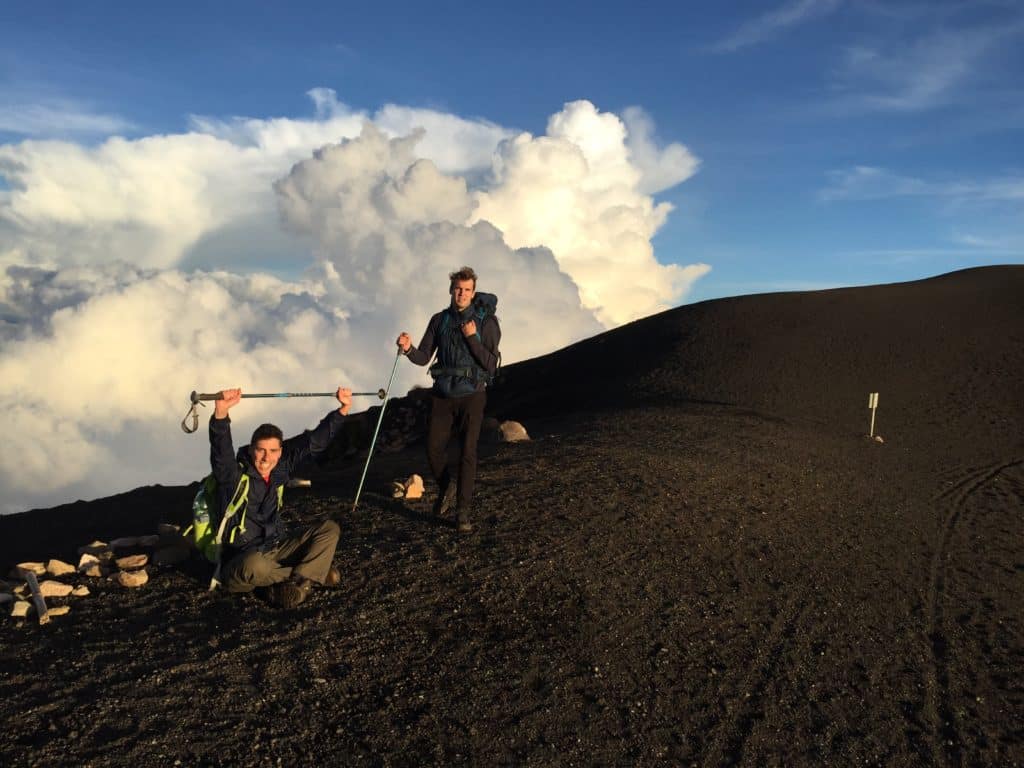
We’re only 400m from camp, but up here it’s another world. Barren volcanic soil yields a few bright yellow flowers. There’s a windswept, otherworldly aura, the clouds suddenly a carpet rather than a ceiling. Fuego sends great forests of ash into the air, mingling with the clouds and hanging over the peaks like an angry ghost. Other climbers approach us with congratulatory gladhanding, a convivial bonhomie born of shared struggle.
Suddenly, we’re surrounded by drama. The furious eruptions of Fuego, now below us, sending spiralling dragons of ash into the atmosphere. They merge with luxurious landscapes of cloud, a world of creamy curlicues like whipped yoghurt. They’re dappled with lashing of strawberry red and tangerine by the blazing sunset, itself an exultant festival of furious colours, glittering gloriously upon the glassy blue brilliance of the sky.
Turn your head further, and the sky is darkened by a thunderstorm: a ferocious tribe of black-grey Nimbostratus rolling in from the Pacific Ocean, illuminated by lightning yet somehow below us, its flashes threatening the cities below. Everywhere you turn, you’re confronted with the best photograph you’ve ever seen. All of us are shouting, ‘Look! Look!’ as the sunset unfolds like a kaleidoscope, sending shimmering patterns of light across the magnificent ensemble.
-
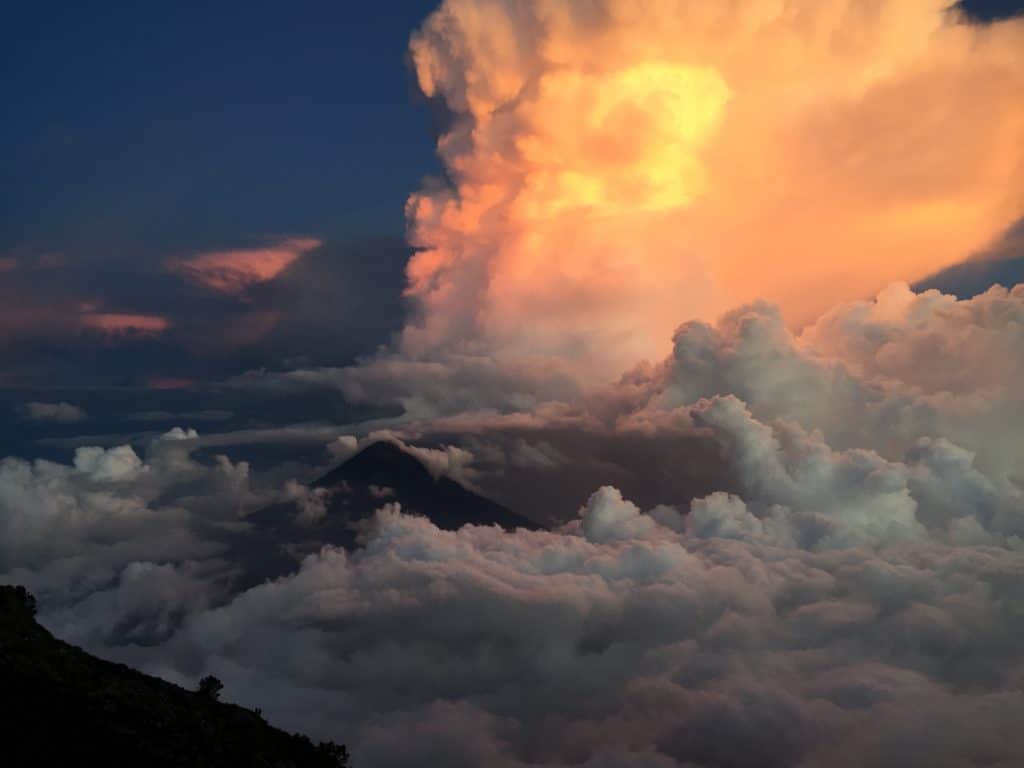
-
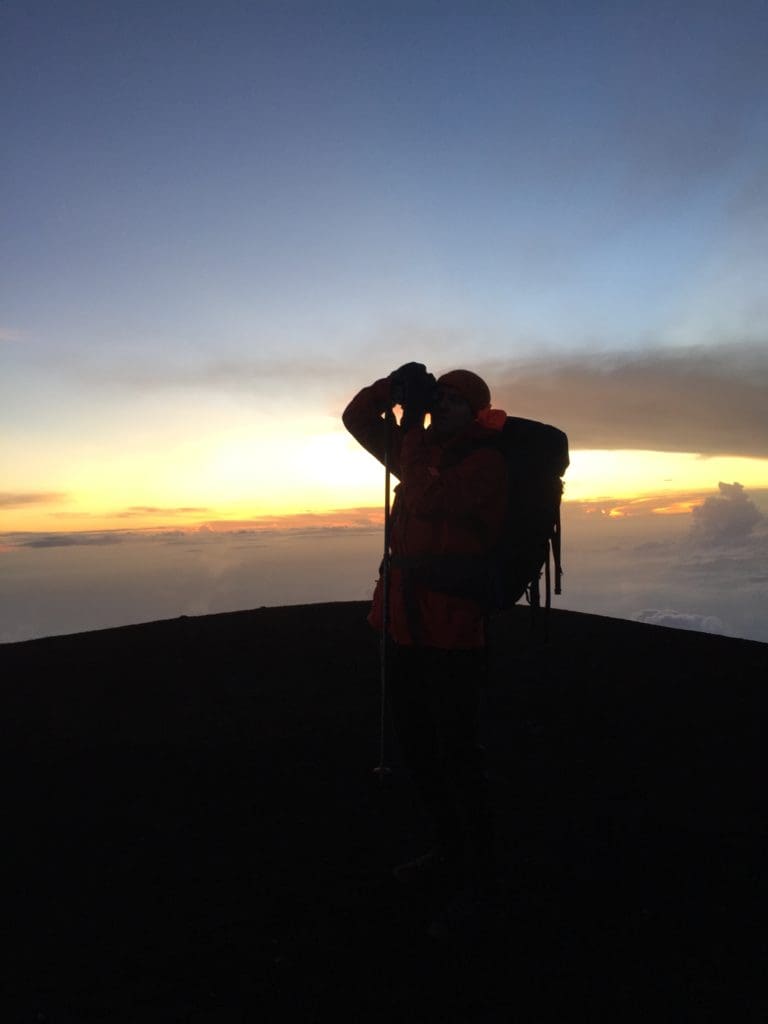
On the summit -
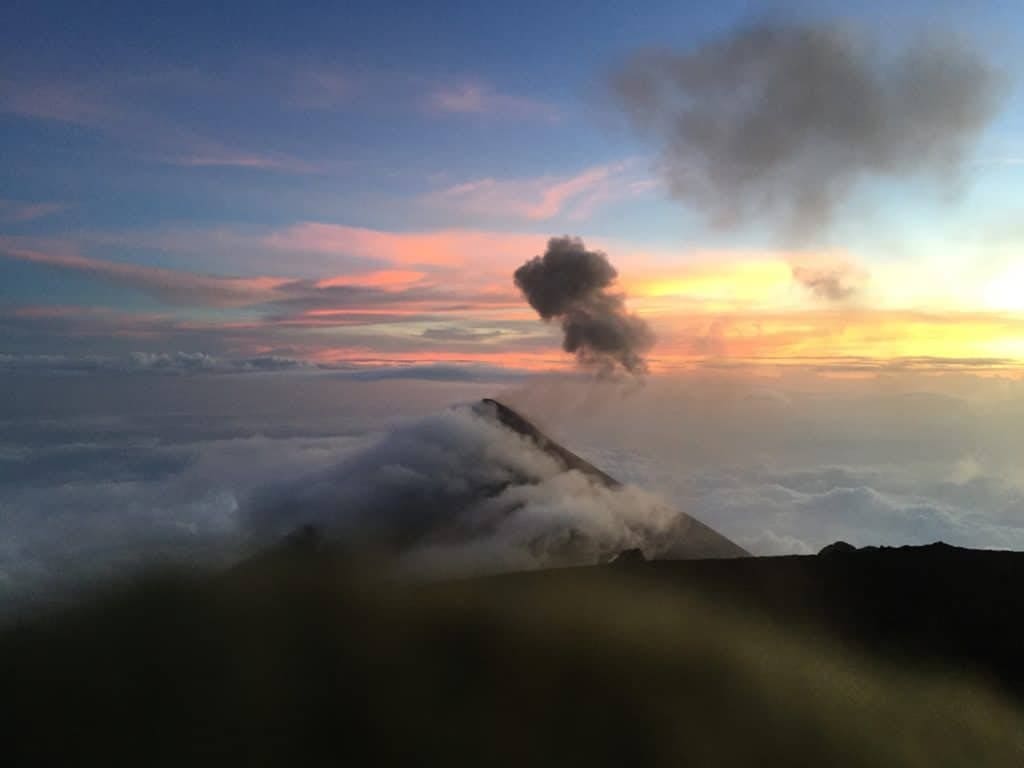
It’s so cold up here, my gloved fingers are numb with pain. But it’s very hard to turn away and begin the descent. Long after the final sunbeam expires in oceans of ash, we finally prepare to abandon the summit. Dusk falls quickly, enshrouding Guatemala below with a sharp silhouette, making the clouds as jagged and noble as mountain ranges.
Now we must descend those 400 metres in the darkness, at a steep gradient, and on slippery volcanic soil. Soon we’re slip-sliding down the slopes in the dusk, suddenly skiers ploughing through snow. Occasionally we face-plant into the soil, our hands blackened with volcanic dirt. The only light comes from the illuminated towns and cities far below. Then it begins to rain.
Tree stumps loom out of the darkness, their misshapen branches somehow witchlike. You hear the ‘sshhh’, the gravel’s rushing sound as it gives beneath your foot. Grabbing onto branches, I try to ease myself down gently, but some parts are so steep you can’t help but simply fall into the darkness.
After an age of cursing and wading, we spot the humble fire of our campsite. It is very, very welcome.
At night, Fuego becomes still more spectacular. Darkness makes the lava visible, and each eruption is highlighted by a fiery burst. We sit together around the campfire, watching in open-mouthed wonder.
I thought that the hardest part of camping on Acatenango would be the cold. But the eruptions are far worse. Every few minutes a rumble – like thunder, like a jet engine, like God – shakes the ground, which is also our bed. In the middle of the night, the bigger explosions wake us. Your dream is interrupted by an awful, apocalyptic moan, the ground shaking with seismic jolts, and for a few seconds of panic you think you’re a goner, no way can such an awesome sound be just another regular eruption, and you cower in your tent half-expecting a volcanic comet to burst in. It’s frightening, it’s primal, it’s unforgettable.
Morning at camp is a magical experience. It’s 5am and the night is fading into a deep blue, which slowly bleeds into something resembling daylight. We sit upon the gravel facing Fuego. It’s the best time to observe the eruptions: light enough to see clearly, dark enough to witness the magma burning bright.
The sun is squatting behind Agua, illuminating its sloping shoulders, giving it a holy dawntime radiance. Shards of fuschia and vermillion streak across the sky, like scraps of flags symbolizing long-lost exotic kingdoms. Our breath lingers in the mist. But the sun is coming, and a sultry central American heat descends upon the day, dispelling the dew.
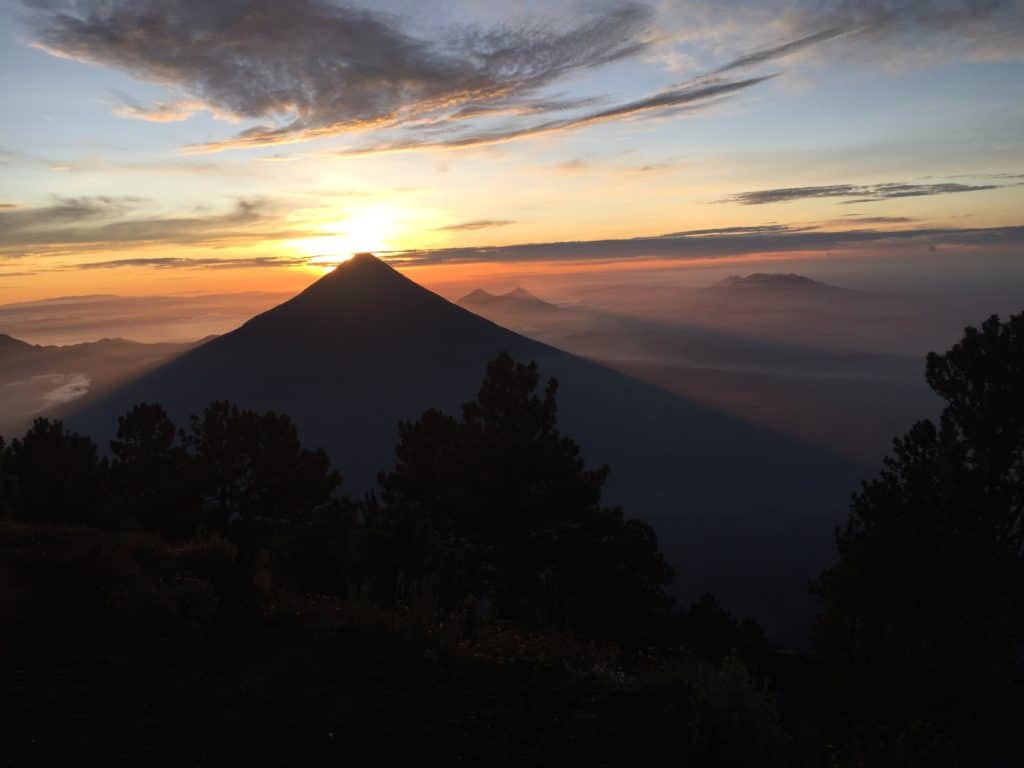
A gaucho’s breakfast of refried beans and plantains baked on an open fire fortifies us for the descent. The first half is easy enough, a pleasant meander through a sunny Alpine woodland. But the second half, through the cloudforest and farmland, is agony.
‘It’s too steep to walk, so the best thing is to run’ David advises.
We hare down the trail, leaping over knobbly roots and skidding through mud. Our calves and thighs haven’t even begun to recover from yesterday, and now they’re getting a total pummelling. More than once I stumble on the rocky ground, arms flailing. Blisters begin to swell on my feet, and by the time we reach the farmland I’ve fallen far behind, limping and exhausted, covered in ashy grime. The hikers I saw yesterday looked better than this.
It takes almost four hours to reach La Soledad. Then we collapse into the minivan. I tear off my boots, lie back on the seat, and watch Acatenango, Fuego and Agua disappearing into the mist.
Porta de Antigua is a good hotel in which to recover. A colonial-style compound, its antiquated stylishness lends our repose a touch of nostalgia. The rooms encircle a wide green plaza, with swimming pools and parrots and happy children. After a long, long shower, I sit in the shade with a drink and a book, enjoying sea-level.
The town itself shares this laid-back, colonial atmosphere. A grid of cobbled streets filled with churches, bars and hostels, Antigua is a favourite of backpackers and tourists alike. The cobbles slow traffic to a crawl, favouring pedestrians.
Strolling through the streets, feeling my legs slowly return to normal, I feel like a survivor. Everything in the town, from the pretty little bakeries to the bone-white Church of San Francisco, looks like hard-won treasure. The climb has purified the world, making it fresher and sweeter. As the sun drops into the Pacific, the sleepy town gets sleepier. And up above squat the dark peaks of Acatenango, Fuego, and Agua, like guardian giants, watching over us.
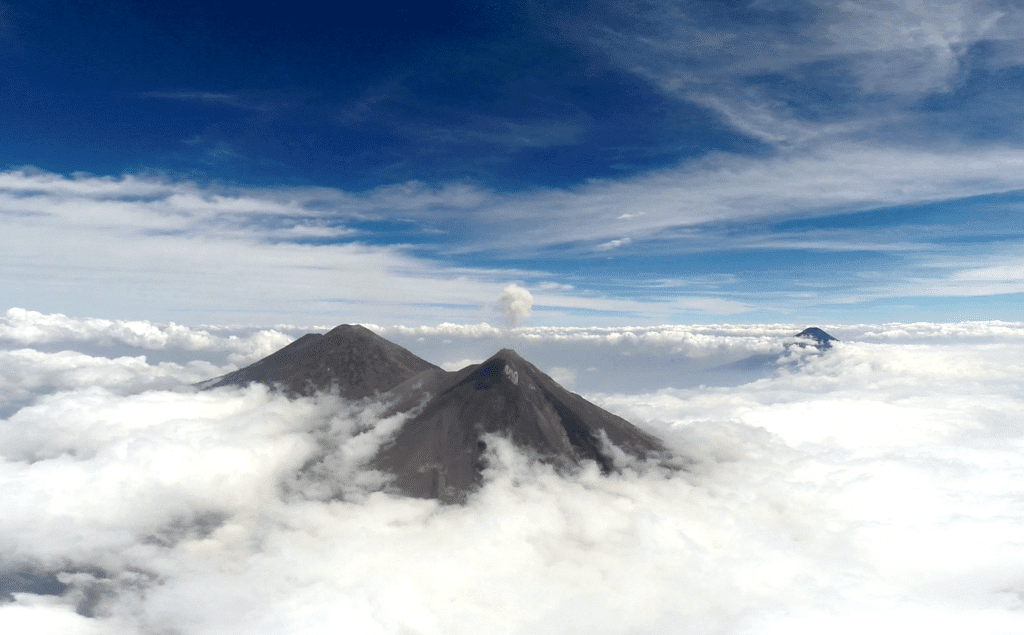
Plan your journey to Guatemala with the Central American Tourism Agency (CATA)
Fly to Guatemala City from London Heathrow. Get there faster with the Heathrow Express, from central London to the airport in just 15 mins


